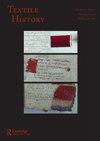Why Early Modern English Clothiers Started Using Spanish Wool
IF 0.1
2区 社会学
0 HUMANITIES, MULTIDISCIPLINARY
引用次数: 1
Abstract
English clothiers began using Spanish merino wool in the late sixteenth century. A small, closely related group of clothier, merchant and mariner families in the west of England drove this initiative. Why they did so is debated. This paper analyses the factors driving the clothiers’ decision. Production, supply and price can be discounted as there was an adequate supply of both English and Spanish wools and the preferred Spanish Segovia wool became more expensive than the best English wools around 1600. The relative and changing quality of Spanish and English carding wools was the crucial issue. The clothiers competed in the domestic and international markets for luxury woollens and sought the best quality wool. Spanish wool’s improvement meant that, once secure supply chains for raw materials and the technological hurdles in weaving a lightweight cloth with short-fibred merino wool had been overcome, the future of Spanish wools in England was assured.为什么早期现代英国服装设计师开始使用西班牙羊毛
16世纪末,英国服装商开始使用西班牙美利奴羊毛。英格兰西部一小群关系密切的服装商、商人和水手家庭推动了这一举措。他们为什么这么做还有待商榷。本文分析了影响服装商决策的因素。生产、供应和价格可以打折,因为英国和西班牙羊毛都有充足的供应,1600年左右,首选的西班牙塞戈维亚羊毛比最好的英国羊毛更贵。西班牙和英国梳理羊毛的相对质量和变化是关键问题。服装商在国内和国际市场上争夺豪华羊毛,并寻求最优质的羊毛。西班牙羊毛的改进意味着,一旦原材料的安全供应链和用短纤维美利奴羊毛编织轻质布的技术障碍得到克服,西班牙羊毛在英国的未来就有了保障。
本文章由计算机程序翻译,如有差异,请以英文原文为准。
求助全文
约1分钟内获得全文
求助全文
来源期刊

TEXTILE HISTORY
HUMANITIES, MULTIDISCIPLINARY-
CiteScore
1.00
自引率
0.00%
发文量
0
期刊介绍:
Textile History is an internationally recognised, peer reviewed journal and one of the leading publications in its field. It is viewed as an important outlet for current research. Published in the spring and autumn of each year, its remit has always been to facilitate the publication of high-quality research and discussion in all aspects of scholarship arising from the history of textiles and dress. Since its foundation the scope of the journal has been substantially expanded to include articles dealing with aspects of the cultural and social history of apparel and textiles, as well as issues arising from the exhibition, preservation and interpretation of historic textiles or clothing.
 求助内容:
求助内容: 应助结果提醒方式:
应助结果提醒方式:


